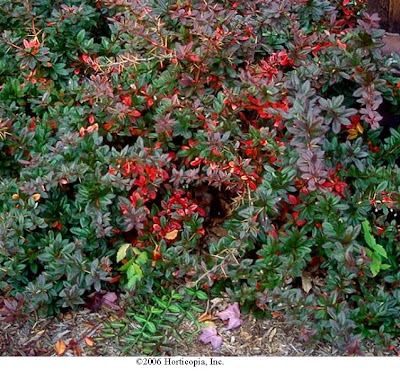Type Shrub, woody plant
Hardy range 5A to 7B
Height 4' to 6' / 1.20m to 1.80m
Spread 4' to 7' / 1.20m to 2.20m
Growth rate Slow
Form Rounded
Exposure Full shade to full sun
Persistence Evergreen
Bloom Color Yellow
Bloom Time Spring
Environment
This plant tolerates some drought. This plant will grow in dry soil. Suitable soil is well-drained/loamy, sandy or clay. The pH preference is an acidic to alkaline (less than 6.8 to more than 7.7) soil.Leaf Color Green and purple
Fall Color Red
This plant has attractive fall colors.
Culture Notes
Barberry is thorny, so it's useful for barrier plantings. The plant tolerates most light exposures and soils. This shrub grows slowly but transplants easily. It grows 3 to 6 feet tall and spreads 4 to 7 feet. Barberry can be sheared and used as a hedge plant. The main ornamental features are fall color in shades of red. The plant produces yellow flowers, but these are not highly ornamental. This plant is considered mostly allergy free and causes little or no allergy problems in most people.
Planting and establishing shrubs
The most common cause of young plant failure is planting too deep. Plant the root ball no deeper than it was in the nursery. In most instances, the root flare zone (point where the top-most root in the root ball originates from the trunk) should be located just above the landscape soil surface. Sometimes plants come from the nursery with soil over the root flare. If there is soil over this area, scrape it off. The planting hole should be at least twice the width of the root ball, preferably wider. In all but exceptional circumstances where the soil is very poor, there is no need to incorporate anything into the backfill soil except the loosened soil that came out of the planting hole. Never place ANY soil over the root ball. If a row or grouping of plants is to be installed, excavating or loosening the soil in the entire bed and incorporating organic matter enhances root growth and establishment rate.
Weed suppression during establishment is essential. Apply a 3-inch thick layer of mulch around the plant to help control weed growth. Keep it at least 10 inches from the trunk. If you apply it over the root ball, apply only a one or two inch layer. This allows rainwater and air to easily enter the root ball and keeps the trunk dry. Placing mulch against the trunk or applying too thick a layer above the root ball can kill the plant by oxygen starvation, death of bark, stem and root diseases, prevention of hardening off for winter, vole and other rodent damage to the trunk, keeping soil too wet, or repelling water. Regular irrigation through the first growing season after planting encourages rapid root growth, which is essential for quick plant establishment.

